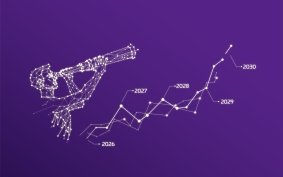As central banks continue to inject liquidity into the financial system, Richard Burrows, Head of Treasury, BACB, examines the perils of hiking up interest rates to control runaway inflation. Even a modest rise, he warns, could see businesses and households struggling to service their debts.
Some of the better-rewarded players in financial markets are traders who have been allocated capital with which to speculate. They can generate impressive returns, and the most successful tend to be those who thrive in periods of volatility.
Yet their success doesn’t always promote a positive perception of financial markets – for example, if such traders work for a bank whose customers prefer them to take risks by lending to the real economy instead. However, the reality is that as central banks injected staggering amounts of liquidity into the financial system as a result of the pandemic – and a growing proportion of this is stuck on bank balance sheets, often in the hands of traders tasked with generating a positive return.
Most stakeholders, especially when setting and reviewing performance against the budget, prefer predictability – particularly in foreign exchange (FX) rates and interest rates. Anyone who claims to be able to predict relative currency valuations generally has a vested interest and is probably positioned a certain way. Future interest rates, however, are slightly easier to speculate on, being one of the underlying determinants in inflation, which in itself is measurable. There has been a recent surge in pundits claiming that inflation is back and that interest rates will have to rise to counter its evil influence. Whether or not this is the case, only time will tell.
Inflation in the three main currency markets – US, UK and Eurozone – is certainly on the rise. An annual UK measure has doubled in a month, but from less than 1% to less than 2%[1]. US year-on-year Consumer Price Index (CPI) has been clocked at 4.2%[2], but that reflects changes since April 2020 when prices were tumbling and indeed deflation was the fear. Does this mean interest rates are going up? Perhaps, but publicly available measures of the probability of future rate moves suggest not immediately, and not by much.
We discuss issues such as these at the Asset and Liability Committee (ALCO), where for a relatively small bank such as BACB, treasury is the de facto in-house economist function. Some of my colleagues – who are thankfully still happy to ask basic questions – ask why these seemingly small changes in inflation expectations attract so much attention and trigger such consternation? Well, the answer may just go back to that issue of how many bonds are sitting on balance sheets.
Many (but not all) bonds tend to pay a fixed rate of interest, so any increase in broader interest rates results in a reduction in value of those bonds. Portfolio managers are rarely forced to sell bonds, but accounting conventions require changes in value to be recognised, either through measures of profit or capital. Small changes in the value of large bond holdings can significantly move the dial in terms of the individual managers’ – and their firm’s – financial position.
An increase in US and UK interest rates of 0.10% or even 0.25% is likely at some stage. Though what is more concerning is the prospect of more significant rate hikes to control runaway inflation. Right now, however, governments and their central banks are still injecting stimulus into their economies expressly to encourage people to spend and foster reflation.
No doubt the views of industry practitioners and experts of a certain vintage are influenced by the memory of the chaos that double-digit inflation wreaked in the 1970s and early 1980s. And it wasn’t that long ago that experienced central bankers were brought up on tales of hyperinflation in the 1930s. More recently though, economists highlight the likely impact of long-term deflationary pressures, such as increasing automation, reduced union bargaining power, ageing demographics and falling global productivity. As economies continue to reopen and consumers have more opportunity to spend their savings, the conflicting dynamics of inflationary and deflationary factors will create some tough decisions for rate-setters. My hunch is that central banks – given their dual objectives of controlling inflation and creating sustainable employment, and as extensions of governments that are elected by taxpayers – may favour risking some inflation without raising interest rates, even if it is at the expense of creating profit-and-loss concerns for some money managers. The economies that underpin the major currencies have encouraged the creation of a debt level that corporates and households would struggle to service if interest rates rose by even quite modest amounts.
[1] Source: UK Office of National Statistics https://www.ons.gov.uk/economy/inflationandpriceindices/timeseries/l55o/mm23
[2] Source: US Bureau of Labor Statistics https://www.bls.gov/news.release/cpi.nr0.htm























